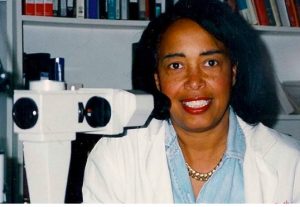2 Dr. Patricia Bath
Dr. Patricia Bath |
 |
Time period: 1942 – 2019Subject: Chemist |
|
Biography:After graduating from high school, Dr. Patricia Bath attended Hunter College, where she earned a bachelor’s degree in 1964. She then attended Howard University to pursue a medical degree. Dr. Patricia Bath graduated with honors from Howard in 1968, and accepted an internship at Harlem Hospital shortly afterward. The following year, she also began pursuing a fellowship in ophthalmology at Columbia University. Through her studies there, she discovered that African Americans were twice as likely to suffer from blindness than other patients to which she attended, and eight times more likely to develop glaucoma. Her research led to her development of a community ophthalmology system, which increased the amount of eye care given to those who were unable to afford treatment. In 1973, Bath became the first African American to complete a residency in ophthalmology. She moved to California the following year to work as an assistant professor of surgery at both Charles R. Drew University and the University of California, Los Angeles. In 1975, she became the first female faculty member in the Department of Ophthalmology at UCLA’s Jules Stein Eye Institute. |
|
Summary of their contributions:Dr. Patricia Bath was an ophthalmologist known for inventing the Laserphaco Probe, a tool used in cataract surgery. After obtaining a medical degree from Howard University, she attended Columbia University and was the first African American to complete an ophthalmology residency program (1973). She was the first woman to chair an ophthalmology residency program (1983). For 5 years, Bath worked on the Laserphaco Probe, a device that was able to precisely treat cataracts and even restore the sight of people who had been unable to see for 30 years. In 1988, she received a patent for the Laserphaco Probe, becoming the first African American female doctor to receive a medical patent. She continued her work in ophthalmology until 1993, when she retired from UCLA Medical Center. |
|
Integration with the BC Secondary Science Curriculum:Anatomy and Physiology 12 in the BC’s science curriculum consists of content relating biotechnology, organ systems of the body as well as disease. In addition. through her studies at Columbia University, Dr. Patricia Bath discovered that African Americans were twice as likely to suffer from blindness than other patients to which she attended, and eight times more likely to develop glaucoma. Glaucoma is a group of eye conditions that damage the optic nerve, the health of which is vital for good vision. Glaucoma is one of the leading causes of blindness for people over the age of 60. The curricula competencies for anatomy and physiology 12 focuses on considering the role of scientists in innovation and implementing multiple strategies to solve problems in real-life , applied , and conceptual situations. |
|
References:https://curriculum.gov.bc.ca/curriculum/science/12/anatomy-and-physiology https://www.mayoclinic.org/diseases-conditions/glaucoma/symptoms-causes/syc-20372839#:~:text=Glaucoma%20is%20a%20group%20of,over%20the%20age%20of%2060. https://cfmedicine.nlm.nih.gov/physicians/biography_26.html https://www.invent.org/inductees/patricia-bath
|
|
